TRAINING NOTEBOOK ❘ By Greg Sellers
On arrival at a residential structural fire, your company is assigned to perform a primary search, which we know from basic training is a quick search of an occupancy to look for possible victims. Whether you’re assigned to a truck, a rescue, or an engine company, this critical task must be completed as soon as possible after arrival of the first-due companies.
So, you grab your tools, go to the entrance of the structure, mask up, and enter with your partner (typically your company officer). After a quick sweep around and behind the entrance door, you focus your search on the bedrooms’ means of egress, where most victims are found.
- House Fire 101
- Civilian Rescue: The Reason We Exist
- Aggressive and Practical Search: It’s Still About the Victim
- MORE AGRESSIVE SEARCHES: MORE LIVES SAVED?
As you proceed down the hallway, you stay low, ensuring a solid floor, and move toward the first room. Before you enter the room, you leave your tool with your partner (better to feel with your hands). Your partner stays at the door and will now assist in guiding your search with the thermal imaging camera (TIC), paying attention to the hallway conditions, maintaining your means of egress, and staying in constant voice contact with you.
You sweep the room doing a righthand search, moving with a purpose, staying oriented to the wall, and sweeping with your hands. You get to a closet; you sweep with your foot and feel the three walls of the closet—no victim.
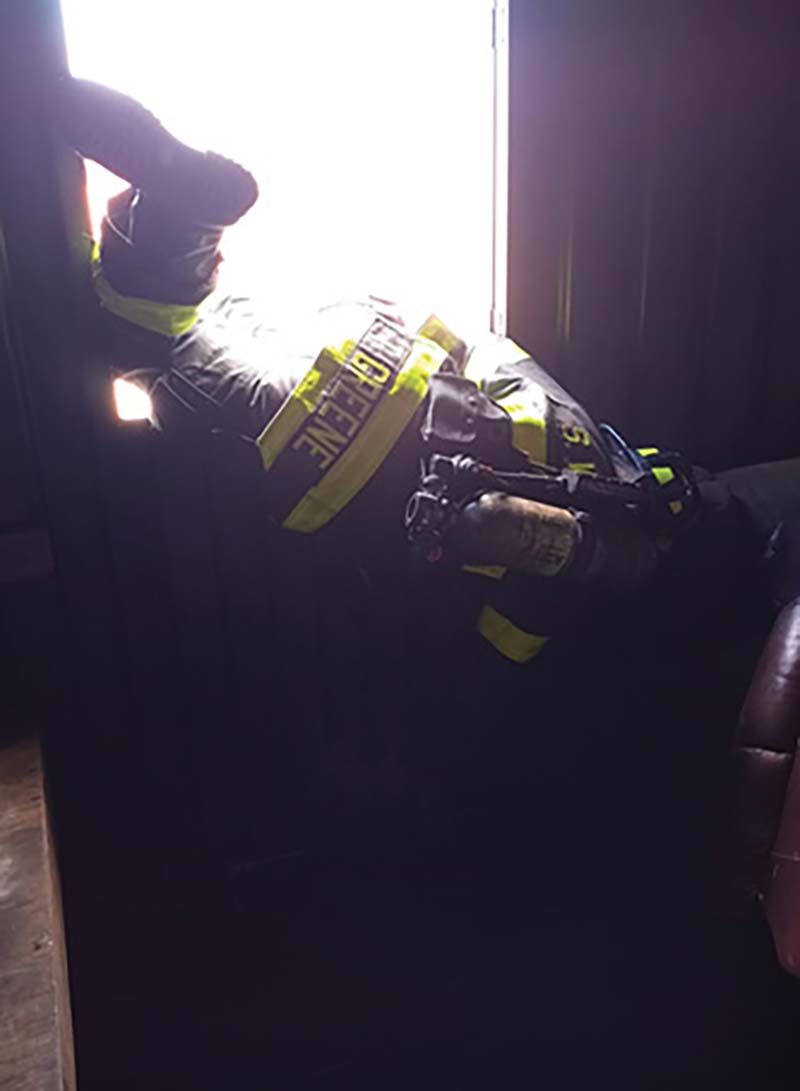
(1) It is imperative that the firefighter making entry stay low, keeping his body out of the heat/smoke and putting him closer to the floor on entry. (Photos by author.)
You keep moving. You find a bed. You reach up and sweep and gather the sheets—no victim.
You keep moving to the other side of the room and you find a victim. You call out to your partner, who then leaves his tool and a hand light at the door (for orientation) and moves to assist you with the removal. He also gets on the radio and notifies command that you have found a victim.
Together, as a team, you move the victim to the hallway, where other companies assist in the rescue to the exterior. You pass the victim to emergency medical services personnel.
This scene is played out throughout the country and hopefully has a successful outcome. This is a basic Firefighter I skill that must be mastered. This article will review some of the basics of the primary search.
Size-Up
Everything we do is based on continual size-up of the scene, whether it’s the building layout, construction, fire location, known or possible victims, exposures, or even staffing. We must understand the basic layout of the buildings in our area. This will give us an understanding of the locations of rooms, access points, hazards, and roof types. Knowing the common locations of the bedrooms will help with a successful rescue.
For example, in new housing developments, the bedrooms in single-family homes are commonly not located together. The master bedroom is likely to be located on another floor or other end of the house from the rest of the bedrooms. In communities with a large immigrant population, bedrooms or single-room occupancies may occupy attics that have been renovated into finished half-stories, basements, and attached garages. Statistically, most victims are found in the bedrooms, a path of egress such as a hallway, a doorway, or under windows.
Statistics also show that it is common to find family members close to each other. It’s human behavior: Children will seek their parents or an older sibling, and parents will attempt to help their children. Accordingly, if you locate victims, sweep the area around them. It is likely that you will find another family member within arm’s reach.
The front door in many homes swings toward the bedrooms. Window size and location will also help us: Small windows on upper floors or on one end of a residential structure are usually bedrooms or bathrooms. Larger windows on first floors may be a living room or kitchen.
Window air-conditioning (AC) units are also indications of occupants. Attic spaces sometimes have AC units, which can indicate an occupied space such as a bedroom. Wheelchair ramps are also a clue as to possibly a disabled person who is bedridden.
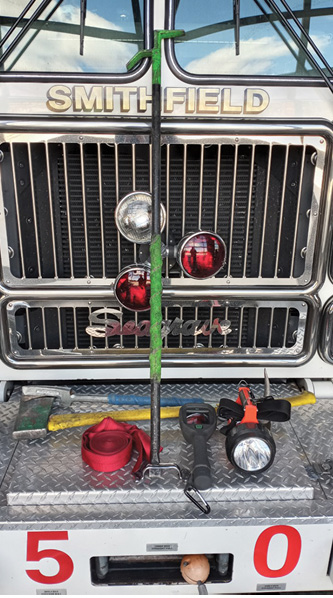
(2) Typical tools for residential primary search: a halligan/flathead ax, a thermal imaging camera, a short hook, webbing, and a good working flashlight.
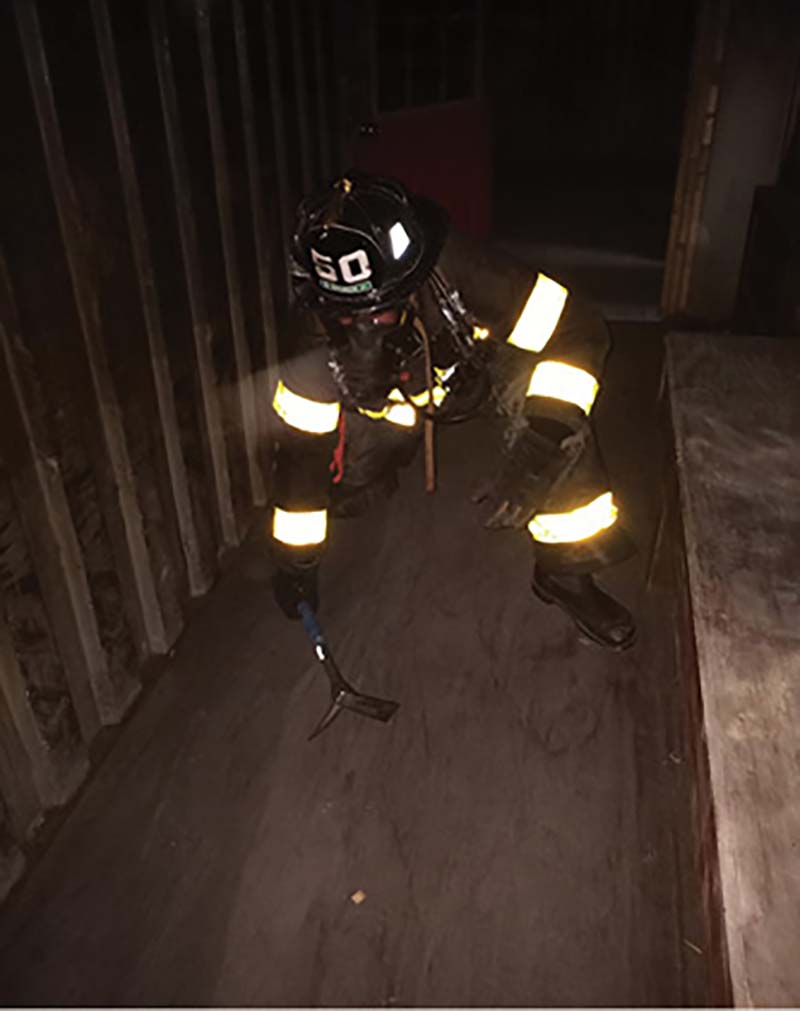
(3) Search using a one-knee-up/one-knee-down position; this allows the searching firefighter to sound the floor, move quickly, and keep his head up and his eyes forward.
Another big indicator of potential occupants is cars in the driveway or children’s toys outside. It is not always a definite, but this will give you an indication based on time of day whether the structure is still occupied. Remember that even though it’s 1:00 p.m. and no vehicles are in the driveway, it doesn’t mean that no one is home. People work different shifts, children stay home from school, the elderly may not have vehicles, and so on. If a bystander is telling you that the building is unoccupied, do not rely on that solely. You must enter the building and perform a proper search, knowing the building is not clear until the fire department clears it.
Before You Enter the Building
Prior to arrival, you should already know who is making the primary search and what tools you are bringing. This assignment can be done at roll call, based on riding assignments or the officer’s direction. Make sure your personal protective equipment is complete and proper and you have a good working flashlight. Tools of choice can be personal preference or department mandated. Typically, they include a set of irons (you may have to force the door), a TIC, or maybe a small hook. Personal tools can include webbing, which can be used to secure a door, extend your reach, or even drag a victim. Be sure your self-contained breathing apparatus cylinder is full and completely operational. You do not want to be at the front door and find out that your equipment is not in working order.
Your officer should complete a 360° size-up that may change your entry point based on conditions, hazards , or a closer access point to the interior stairs, so be ready for that change. Take another quick look at the structure prior to entering; this will allow for another look at the outside and changing fire conditions.
Making Entry and the Search
Once you make the door, stay below the smoke/heat line, if possible. This will allow you to move fast, hopefully have some vision, and keep you out of the upper-level heat conditions. If you are going to the upper floors, many times the stairway is located near the front door. Another good tip is to tell the floor-below engine company that you are going to the upper floors. This is so they know they have to protect the crews searching on the floors above them with their hoseline.
Communication with your partner is key; talk to each other but don’t have a “conversation.” Use quick statements like “Going right” and “Table in the hall.” For years, it was taught that you should maintain physical contact with your partner. This is unsafe and impractical, as you’re usually just playing follow the leader. Also, if something happens such as a floor collapse or a fall down the basement stairs, chances are both of you are going to fall because of physical contact. Plus, you can cover a much greater area in voice contact rather than being physically tethered.
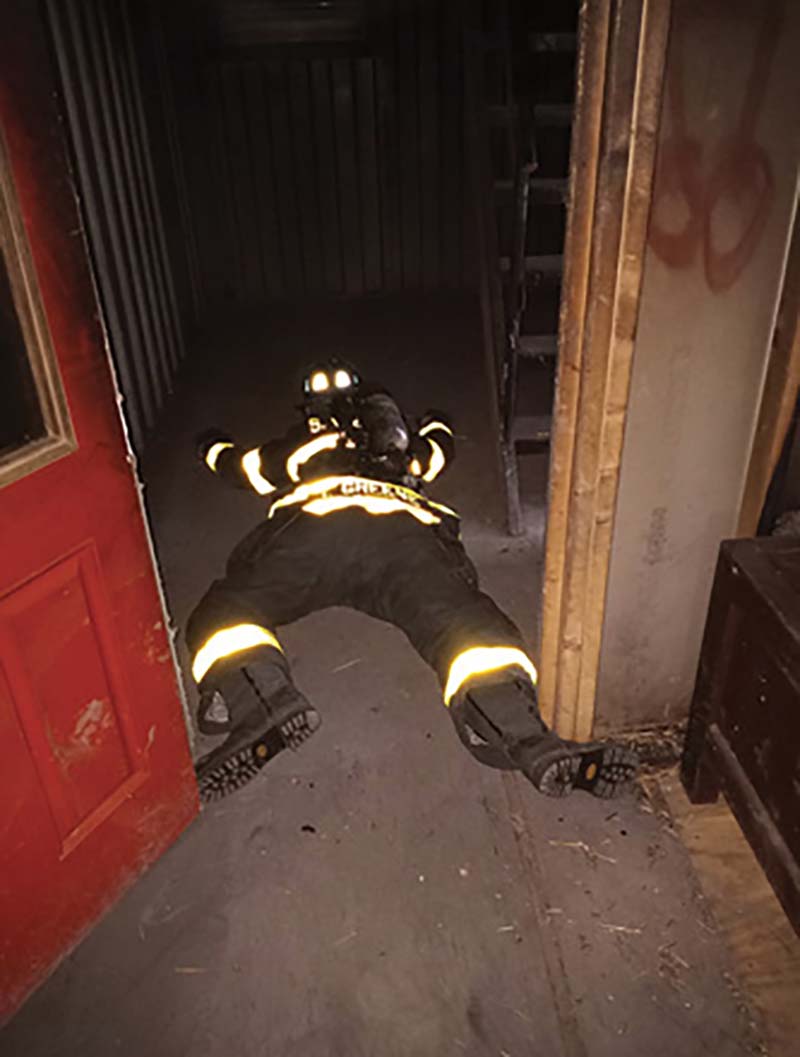
(4) Before closing the door during VEIS, get low, hook your foot around the doorframe, and stretch out your body to search for any victims in the hallway leading to the room.
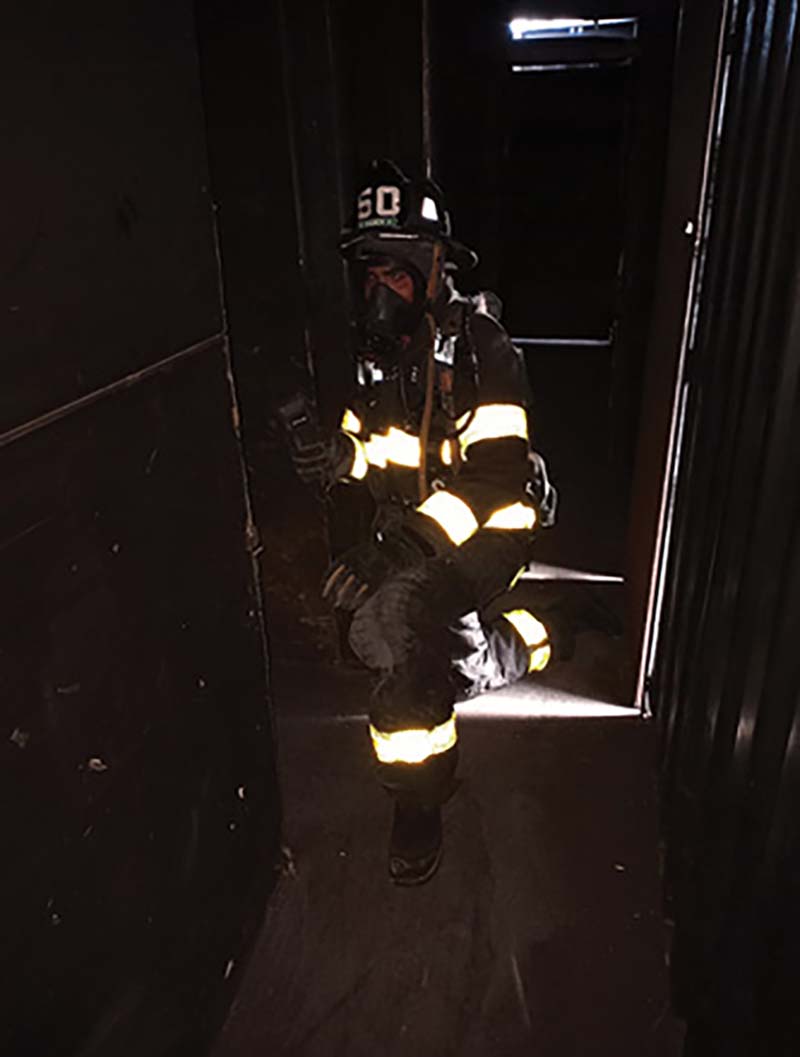
(5) Have the nonsearching firefighter stay at the door while the searching firefighter is in the room; this allows situational awareness as to hallway conditions, means of egress, and communication.

(6) If you find a crib, tilt it down and reach inside to look for victims; be sure to sweep/grab blankets and sheets.
Stay oriented to a wall and know where you are in the building. Remember what side you came in on (side A or side 1) and the turns you make so you don’t get lost. When you crawl, do not stay on “all fours”; use a leg out and a knee up. The outstretched leg will help you sound the floor for stability and any other obstacles. You can also move faster this way, and you can keep your head up so that you can hopefully see or use the TIC. It’s not a bad idea to call out; if the victims are still conscious, they may hear you and respond back. Then you can follow their voice.
So now that you have found a room, have your partner stay at the door and you go in to search. Leaving a firefighter at the door allows communication between firefighters and lets the firefighter watch the hallway and fire conditions, maintain the path of egress, and direct another crew if needed.
Typical bedrooms are 10 feet × 15 feet (every house is different). Two firefighters searching an average size bedroom will become too cluttered, and you’re going to get in each other’s way. For larger rooms, such as a master bedroom with an attached bathroom, a two-firefighter search may be appropriate. On entering the door to the room, one firefighter proceeds to the right and the other to the left.
Once you enter the room, stay oriented. A room usually has four turns and four walls, so pay attention to that. When you get to a room, the door should give you some indication as to what type of room it is. Inward-swinging doors are usually bedrooms and bathrooms, Outward-swinging or sliding doors are usually closets or basement access.
If you find a closet, do not put your body in it. Firefighters have died by getting trapped in closets. Use your leg, outstretch your arms, or use a tool to extend your reach. If you find a victim, then you must make a decision as to how to rescue the victim. Move quickly but make sure you cover the room, sweeping with your hands under beds, under chairs, and behind furniture.
When you reach a bed, get up next to the bed or, if possible, stand, sweep the sheets, or gather the sheets. If you find a victim, check for another. Also, check for bunk beds by stretching your arm to check above you. If you find a crib, tilt the crib and reach into it; sweep the crib. When you get to a bathroom, be sure to check the shower or bathtub. (I once found an unconscious victim in a bathtub in a structure we were told was unoccupied.)
A lot of discussion centers around the ventilation of a window to improve conditions. If you know that a hoseline is at the fire or that you’re not going to create a flow path that will make conditions worse or cause a rapid fire event and it will make your search better, I say ventilate the window; it’s a game-day decision with good judgment.
Once you complete the search, you should be back at the door. Move to the next room. Maybe switch roles and now you stay at the door and send your partner to search the next room.
Once the search is complete, notify command, “Primary search second floor negative.” If you find a victim, you most likely will need assistance, so call for it. Also notify command that you found a victim and where you’re bringing him out. In recent years, some departments have been training to have tools but not use the tools to extend a search. The thought is you can feel with your hands, not your tools, and your tool may injure the victim, so remember, “your hands are your eyes”; think about what you’re feeling. You are looking for bodies or people, so that is what you should be feeling for. Have your tools in a place where you can get to them, such as a doorway.
This is also based on room and structure size. There are also many departments that search off a hoseline. If you’re an engine company and there is no one else to do the search, this is a valid option. Remember, searching off a hoseline slows down the search and is another “tool” we have to manage.
Truck or rescue companies rely on the engine company to protect them, and not having a hoseline speeds up the search.
Vent-Enter-Isolate-Search
This valuable tactic is for a known location of victims or when you’re trying to get to an upper floor and cannot access the first floor because of fire conditions or lack of stairs. This is done by a two-firefighter crew usually on an upper floor with a ground ladder.
When a bystander is telling crews on arrival that a victim is located in a specific upper-floor room, it is often faster to throw a ladder and enter the window to effect a rescue. The placement of the ground ladder is key: The tip must be placed just below the windowsill. If it is into the window even a few inches, it will make it difficult to enter, to remove a victim, and for the rescuing firefighters to exit.
With the heels of the ladder embedded in soil so they won’t slide away from the building, place the ladder at a roughly 60° angle as opposed to the normal 75°. A ladder placed at this angle makes it more of a slide to assist in carrying a victim down a ladder, and if a searching firefighter has to bail out of a window headfirst, he can slide all the way down to the ground without having to upright himself.
Once the search firefighter reaches the top of the ladder, he must remove all glass, shades, sash, and blinds to provide an unobstructed entry. Once the window is completely cleared of any obstructions, give the room a couple of seconds to “settle,” meaning make sure the new flow path that you have created doesn’t produce a rapid fire event.
Before entering the room, make sure you have a solid floor by sounding it. Once you have determined the floor is solid, place your tool at the floor near the corner under the interior windowsill. Roll your body headfirst into the window, keeping your head low, similar to a window bail. This keeps your upper body out of the heat and smoke now coming out of the window.
Next, get to the door and close it as quickly as possible. A lot of times, the door is opposite the window, so stay low to the floor below the smoke line, if possible, and crawl to the door to close it.
If you find a victim before you get to the door, continue to the door and shut it. It’s going to buy you time and protection once you close the door; then work on victim removal. Once you reach the door, stay low, hook your foot around the doorframe, and stretch yourself out to search the hallway around the door for victims. Then back into the room and shut the door. Now do a rapid, organized search as previously discussed. Have your partner come to the tip of the ladder to communicate with you and assist your search with the TIC. Once your search is complete, exit the window onto the ladder and notify command.
These are just some quick tips to aid in your search techniques. Every department has different tricks and thought processes, so master those, but also know your basics. The basics are what save lives. Use technology such as a TIC to help, but don’t rely solely on technology. A well-trained, well-prepared search crew is what the citizens expect. Their lives depend on it.
Greg Sellers is a 30-year career and volunteer fire service member. He is an instructor in engine, truck, and live fire operations. His fire service career began in Tonawanda, New York.

